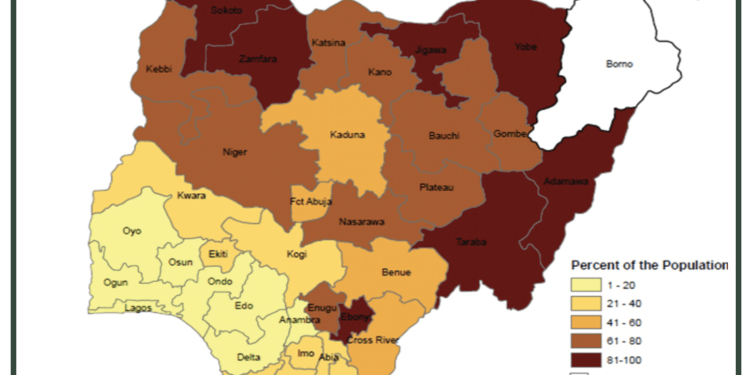With a staggering population of 205 million people, over 80 million Nigerians live in poverty. This is according to the Nigerian Living Standards Survey report published by the National Bureau of Statistics. The recently published data indicates that 40.09 percent of Nigerian are poor. Whereas the poverty rate in urban areas is only 18.04 percent, as much as 52.1 percent of rural dwellers are poor.
The report also revealed that northern Nigeria had the most poverty headcount rate. Across geo-political zones, North-Eastern Nigeria had the most poverty average while South Western Nigerian had the least. The average poverty headcount rate by geo-political zone is North Central (42.7 percent), North East (71.86 percent), North West (64.84 percent), South East (42.44 percent), South South (21.28 percent), and South West (12.12 percent).
Average Poverty Headcount Rate by Geopolitical Zone
Geo-Political Zone | Average Poverty Headcount Rate (%) |
North Central | 42.70 |
North East | 71.86 |
North West | 64.84 |
South East | 42.44 |
South South | 21.28 |
South West | 12.12 |
Also, the report indicated that the states with higher poverty rates are Sokoto (87.73 percent), Taraba (87.72 percent), Jigawa (87.02 percent), Ebonyi (79.76 percent), Adamawa (75.41 percent), Zamfara (73.98 percent), Yobe (72.34 percent), Niger (66.11 percent), Gombe (62.31 percent), and Bauchi 61.53 percent.
On the other hand, Lagos (4.5 percent), Delta (6.02 percent), Osun (8.52 percent), Ogun (9.32 percent), Oyo (9.83 percent), Edo (11.99 percent), Ondo (12.52 percent), Anambra (14.78 percent), Kwara (20.35 percent), and Bayelsa (22.61 percent) had the least poverty rate in the country.
According to the report, over 44 percent of the states in Nigeria have poverty ratio of over 50 percent. by implication, over half of the population in 16 of the 35 states and the FCT live in poverty. The survey excluded Borno State, as some parts of the state were not safe to visit.
Poverty limits access and declines productivity.
Overall, poverty in Nigeria is worsening health standards, limiting access to education and deteriorating living standards. While four in every ten Nigerians are poor, quality of life measurements is also tending towards the negative. Thus, hopes of the Nigerian masses appear unpredictable. As Nigeria battles its poverty crises, the country is also experiencing increasing growth in insecurity, violence, and crime. With rising levels of poverty, Nigeria’s security may continue to be hampered. Also, poverty hampers human health which in turn limits productivity.
From the NLSS survey report, it is important that the government rethink its poverty reduction strategy. It needs to develop more effective solutions. In doing this, the government should understand that poverty is a structural problem and that there is a need for synergy between the social and economic sub-systems to achieve real changes. Private sector partnership, as well as coordination between the national and subnational governments, can also help to improve the poverty outlook.
With the variations in poverty levels across states and geo-political zones, a uniform poverty alleviation strategy might not produce desired results. Rather, poverty reduction strategies should be developed to have state and regional outlook. This would improve effectiveness and ensure that proposed solutions meet specific local needs.


